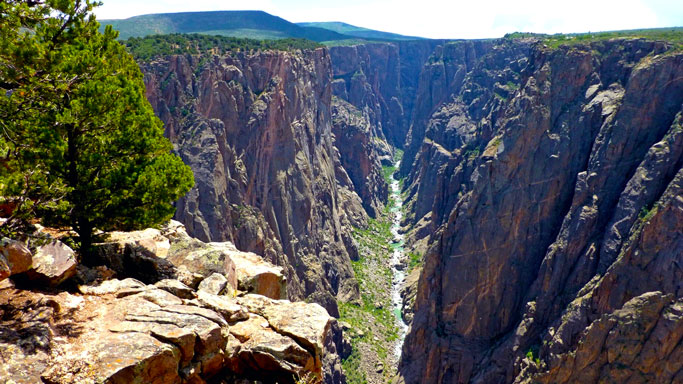In This Issue...
- Comments from the Chair
- September General Meeting — Impacts of Impervious Cover — What Science Can Tell Us
- Utility-scale Solar in Texas — Boom, Bust, or Short-term Slowdown
- September Lions Field Event — The Human Scale
- Apply to Become a SA Planning Commissioner
- Youth Outdoors Guadalupe River Outing
- Seen This One? Black Canyon of the Gunnison National Park
- The 2016 Mayor’s Housing Summit
- Efforts to Reduce Feral Hog Numbers Show Promise
Table of contents items link to the stories. Click the back button on your browser to return to the table.
Comments from the Chair
SA Tomorrow Plan
August started badly. The COSA Planning Commission stripped the SA Tomorrow documents of meaningful regulatory language, especially about Dark Skies and Impervious Cover. These last were reinserted but without anything more than the weakest of “study” and “stakeholder” language. Meaningful regulatory language was systematically stripped from all three documents (Comprehensive Plan, Multimodal Transportation Plan and Sustainability Plan) clearly at the insistence of developers. Even some things as small as mentioned protections for the Edwards Aquifer Recharge Zone, and paying a minimum wage were removed.
Councilmembers Nirenberg, Saldana, Gonzales and Trevino are to be thanked for supporting reinstatement of regulatory language that would have given teeth to these documents. The Mayor and her spineless City Council allies prevailed, producing another in our long series of “Visions” without substance.
As the Express News editorialized (What comes after SA Tomorrow?, 8/12/16) the SA Tomorrow “plan has struck intense conversation between environmentalists and the development community”. Unfortunately, as Mr. Nirenberg said “The council’s failure to restore the document “tells the public that we have given line-item veto authority to special interests in this community,” i.e.developers. As the editorial concluded “The community is waiting for vision to be married with action.”
The Council has provided us Plans from a two year process that are all vision and no action, with no authority to do more than “study”, “encourage”, “explore” and incentivize”. There is little reason to hope that this SA Tomorrow Plan will result in any different future San Antonio than previous plans: the developers will give us the city than want, i.e. the one that keeps on paying them the most profits for the lowest costs with the fewest regulations.
The Alamo Group responds to this failure with renewed vigor to challenge the decades long developer lock on this city. As SAEN editorial states, SA will grow, and no one can stop it. The question to us is will we continue to add sprawl, air and water pollution, worse flooding, worse traffic congestion, worse habitat and aquifer preservation, worse health, worse social injustice, worse pedestrian, bicycle and vehicular safety etc.? Or will we choose something different than what the developers have chosen for us over the last 4 decades?
Our first fight will be to overhaul the City Planning Commission (see article below), currently stacked with developer supporters. Our longer fight will come in the spring of 2017, when we will push hard for city leaders that will, like Gonzales, Saldana, Nirenberg and Trevino, stand up for all of the community not just the wealthy developer interests.
To all who responded to our action alert in support of SA Tomorrow, dark skies and impervious cover, I thank you very much. For more please check out this article, Citizen Action Leads to Better SA Tomorrow Plan, But It’s Kinda Weak Sauce… For Now, by Drew O'Bryan, Clean Energy Coordinator for the Lone Star Chapter.
Low-impact Development (LID)
One of the important parts of SA Tomorrow gutted by builders was language to make LID our standard for best practice development. LID would mean promoting pervious surfaces, rain gardens and swales to reduce flash floods, following the basic principle of water management to “slow down, spread out and sink in” more rain water.
We will have to continue to work hard to promote LID. Together with rainwater harvesting for storage, these techniques can reduce the costs of floods, and enhance our water resources. Please come to hear more about LID at the September monthly meeting.
Climate Change
SA Tomorrow lacks a Carbon Action Plan to address reducing greenhouse gases, but work on this is beginning thanks to leadership from Councilman Lopez, among others. We will need to work hard to promote this Plan in the face of expected opposition from pro-business leaders like Councilman Krier. A Carbon Action Plan will be important in the context of our impending non-attainment for ozone pollution. It will also be important longer term to mitigate climate changes and associated severe weather events.
July was the hottest global temperature on record, continuing a long trend. Severe weather events are occurring more frequently and with greater severity, as climate change models have predicted. The Louisiana floods are said to be a one in a thousand year event. Together with the California fires, there are in excess of 120,000 Americans displaced from their homes at this time by these events. It is past time to take climate change seriously. It will affect us all.
Politics
With important elections right around the corner, I encourage you to take a look at the Congressional candidates endorsed by the Sierra Club. I strongly urge all members to actively support these candidates, vote for them, and ask friends and family to do the same. They are friends of the environment.
By the time you read this, the Sierra Club Political Committee of Texas will have published endorsements in State races at TurnTexasGreen.org. Please be sure to check these out to help guide your voting for environmentally-friendly candidates.
SA Budget
FY 2017 SA BUDGET is open for discussion, and is expected to come to a vote September 15. Public open houses will be held around our city, and Council district public hearings. There is also an on-line site providing a way to give feedback. Please look at how SA plans to spend your tax dollars and get involved in working for a better environment.
by Terry Burns, M.D., Alamo Group Chair
Impacts of Impervious Cover — What Science Can Tell Us

Impervious cover (buildings, parking lots, streets) causes increased stormwater runoff and flooding, contributes to contamination of the Edwards Aquifer, and harms water quality in creeks and rivers. Stephen T. Graham, P.E., Assistant General Manager of the San Antonio River Authority, will present a science-based approach for dealing with these impacts at our September General Meeting.
Tuesday, September 20th
6:30 p.m.
William R. Sinkin Eco Centro, 1802 North Main Avenue
Map
With his wide expertise as an engineer, Graham is responsible for several programs of particular interest to the Alamo Sierra Club: Low-impact development, water quality in the San Antonio River basin, flood control, and environmental protection. This subject is particularly important for the SA Tomorrow plan, San Antonio's long-range comprehensive planning process. This event is free and open to the public.
Utility-scale Solar in Texas — Boom, Bust, or Short-term Slowdown
Over the last few months, fueled by projections by the Electric Reliability Council of Texas (ERCOT), there has been a lot of talk about a possible 2,057 MW of utility-scale solar being installed in Texas by the end of 2017.
It now appears there is a change in the pace of ground-breakings and construction of utility-scale solar plants in Texas and across the U.S. That fact is being interpreted in different ways. A recent article in the San Antonio Express News hinted at significant electricity grid integration issues as being behind the drop-off, and implying a systemic longer-term problem that will limit solar’s share of the state’s generation portfolio. Some trade journal articles, on the other hand, attribute the change in momentum to the extension of the federal solar Investment Tax Credit (ITC), quenching the flame that was fueling solar developer’s urgent rush to the finish line. The persistently low price of natural gas certainly figures into things as well.

In monitoring media coverage of solar in Texas, and through visits with contacts in the solar and utility industries, it appears to me we are experiencing a stretching of the development timeline but little reduction in the longer-term enthusiasm for putting solar on the ground or the likelihood of robust development. Within the longer timeframe we are likely to see important shifts in environmental and energy policy and impacts of population and business growth in Texas that will further increase demand for solar. And who knows, there could always be a dramatic turn of events resulting in unexpected increases in the price of natural gas.
A story in the Houston Chronicle (Solar seeks to shine through Texas hurdles by Jordan Blum, July 8, 2016) characterizes the situation thusly:
Lincoln - Clean Energy swooped into Texas last year with big plans to build the state's largest solar farm, a $320 million project covering 2,400 acres in the Panhandle and capable of powering 40,000 homes - even on the hottest days. But more than six months after construction was scheduled to begin, ceremonial shovels have yet to break ground on the Nazareth Solar project about 60 miles south of Amarillo. The problem: No one wants to buy the electricity.
The Texas solar rush was supposed to take off in 2016, but as Nazareth Solar shows, it remains far from achieving its promise. At least five major solar projects expected to come online in Texas by the end of 2017 have been delayed or canceled, while some industry giants, such as SunEdison, have filed for bankruptcy.
"You haven't seen quite the liftoff with solar yet in Texas," said Philip Moore, Lincoln's vice president of development. That liftoff was expected to come over the next couple years, but the string of delays and cancellations means the state may add only about half the anticipated 2,000 megawatts of installed solar energy by the end of 2017 (A megawatt can power about 200 homes). The roughly 300 megawatts of grid-scale solar power in Texas account for less than 1 percent of the state's electricity generation, according to the Electric Reliability Council of Texas, which oversees about 90 percent of power grid.
by Russel Smith, independent consultant in renewable energy and Alamo Group Executive Committee member
The Human Scale

Our September Lions Field Event is The Human Scale, a film about the work of Danish architect Jan Gehl. It deals with his studies of the human scale of cities and how they can be designed or improved to make them more interactive and inclusive. This event is free and open to the public.
Thursday, September 22nd
6:30 p.m.
Lions Field Adult Center, 2809 Broadway @ Mulberry
Map
In its review of the film, Variety notes that:
Andreas M. Dalsgaard's excellent urban-planning documentary should enthuse pedestrians, bike riders and public-space proponents everywhere. Taking as its model the work of Danish architect Jan Gehl, “The Human Scale” makes an excellent case for designing cities around people instead of automobiles, traffic flow having dominated city planning since the 1960s.
Visit the The Human Scale website for further information.
Apply to Become a SA Planning Commissioner
The City of San Antonio is seeking applicants to fill available positions on the Planning Commission. The Planning Commission advises City Council on the master plan for the physical development of San Antonio. Those interested in applying for one of the available positions may do so online using the City’s web-based application for boards and commissions.
Applications must be received by September 12th.
The commission also provides recommendations on capital improvements and administers regulations on subdivisions and platting, to include the extra-territorial jurisdiction. Regularly-scheduled meetings are held twice a month on the second and fourth Wednesdays of the month at 2 p.m. at the Cliff Morton Development and Business Services Center, 1901 S. Alamo St., in the first floor board room. Each term is two years.
For more information regarding the Planning Commission, visit the Planning Commission & Technical Advisory Committee webpage. To see who is currently serving, click here. For assistance with your application, contact Brandon Smith, Boards & Commissions Coordinator, at 210-207-7253.
The Planning Commission has been dominated by industry representation for many years. Over-representation of vested interests has resulted in hundreds of decisions that have diminished quality of life here in San Antonio; exemplified most recently by the 5-4 vote to remove Dark Skies and Impervious Cover recommendations from San Antonio’s Comprehensive Plan. View Rick Casey's Texas Week — City’s latest plan to handle growth (Aug. 12, 2016) video for additional insights.
If you apply to serve on the Planning Commission, we recommend contacting your City Council representative to inform him/her that you would like to serve. The Greater Edwards Aquifer Alliance would also appreciate a heads up on your application; please send a message to Annalisa Peace.
by Annalisa Peace, Greater Edwards Aquifer Alliance, Alamo Group member
Youth Outdoors Guadalupe River Outing
On July 23rd, we traveled to Guadalupe River State Park with ten students from the Sutton Oaks San Antonio Housing Authority (SAHA) apartment complex. The students, aged 6-11, waded in the Guadalupe River with nets provided by the park to catch critters and rocks. We ate a healthy lunch and fished with old-fashioned bamboo poles.

SAHA furnished a new fifteen seat van with driver. It was a fun day for all! More trips are being planned.
Want to help?
Your involvement would be welcome! See our Sierra Club Youth Outdoors web page. The Youth Outdoors committtee meets on the 1st Tuesday of every odd month at 7 pm at the University Presbyterian Church, 300 Bushnell. Contact Anne Pearson, (210) 408-6321, for information.
by Gay Wright, Executive Committee Secretary and Tablings Chair
Seen This One? Black Canyon of the Gunnison National Park
Black Canyon of the Gunnison is #1 in a Nature.com (Nature Conservancy) article, 10 Great National Parks You’ve Never Heard Of. It is located in central southwestern Colorado, 60 mi SE of Grand Junction, 80 mi SW of Aspen, with the closest town being Montrose.
"Deep, Steep and Narrow..."
Big enough to be overwhelming, still intimate enough to feel the pulse of time, Black Canyon of the Gunnison exposes you to some of the steepest cliffs, oldest rock, and craggiest spires in North America. With two million years to work, the Gunnison River, along with the forces of weathering, has sculpted this vertical wilderness of rock, water, and sky.
(from the park home page).
The Gunnison River defines the park in its course through the Gunnison Uplift. The most popular side of the river is the south. The South Rim Road runs from the park entrance and South Rim campground to High Point on the west, from where there is a nice hike to Warner Point. There are various parking areas with short trails to canyon vistas from South Rim Road. I saw a young mountain lion on such a trail early one morning. The East Portal Road (closed in winter) runs east to another campground near the Gunnison Diversion Tunnel. Due to the solid pile of igneous rock comprising the virtually the entire park, water has to be trucked in; we are asked to conserve, and should bring some of your own.
Some of the most interesting views are from the north rim (my photos below), which is much less visited and closed in winter.


Further about the park
At Black Canyon of the Gunnison water is available at campgrounds only mid-May to mid-September. There are a couple routes from rims to the river, but these are very challenging, with names like SOB Draw (apparently famous for poison ivy). The hikes along the rims are much friendlier.
Before getting to the national park from the east the Gunnison River flows through Curecanti National Recreation Area (NPS). There are a lot of water activities here and 10 campgrounds; here's the map.
West of the national park the river flows through Gunnison Gorge National Conservation Area (BLM), which is popular for rafting. River access here in some spots is only via rough roads, 4WD advised, but there are some lovely quiet campgrounds. Further west the Gunnison joins the Colorado at the city of Grand Junction.
The Gunnison diversion tunnel, 6 miles long, was dug to the river at the east end of what is now the national park through the rock from the farm lands on the south side, in 1909. You can see the inlet from the end of East Portal Road. The vast expanse of farms sustained by this water is visible 2500' below from the top of the south rim park entrance road. Here's the Wikipedia page.
Other national parks "you've never heard of"
The excellent Nature article mentioned above was incorrectly attributed, in an August newsletter article about Capitol Reef National Park, to Backpacker.com. The latter is nonetheless is a good source of hiking and travel information.
In addition to our August story about Capitol Reef, our February 2016 newsletter covered Guadalupe Mountains National Park in Texas (#7 in the Nature article). See our November 2015 newsletter for an article regarding #8, Great Sand Dunes National Park in Colorado.
by Kevin Hartley, Alamo Group member
The 2016 Mayor’s Housing Summit
It’s that time again for another round of observations and predictions from a collection of speakers focusing on the outlook for housing in San Antonio.

photo courtesy World Federation of Engineering Organizations
One notable highlight is a presentation by Francesco Piazzezi who will be showing how his organization has been providing over 30,000 affordable residences for families in Mexico and Central America since the 1980s. The most exciting detail of the presentation is that these homes are built with compressed earth blocks! With a local movement underway to establish and promote earthen construction in the San Antonio area, this presentation can not be more timely.
The other speakers are local, and the event is free. Full descriptions of the presentations and speakers can be found on the Housing Summit website.
The 2016 Mayor’s Housing Summit will be held at the Henry B. Gonzalez Convention Center on September 30th with three ninety minute presentation sessions throughout the day reflecting five different topic tracts. The event also includes a luncheon keynote speaker and an Open House gathering at the end of the day.
Even though the event is free, reservations are required via Eventbrite which can be accessed through an orange Eventbrite button on the event’s home page. Free reservations will be filled rather quickly, so I recommend your making your reservations for your preferred sessions now.
by Stephen Colley, Alamo Group Executive Committee member
Efforts to Reduce Feral Hog Numbers Show Promise
A familiar chemical could help put a dent in the worldwide feral hog plague. It has hurdles to clear, but studies show promise, according to wildlife biologist John Kinsey. This is not the end-all, be-all control measure, but it can be another tool for hog-control, Kinsey told landowners at the annual Texas Wildlife Association Convention. The success rate of using sodium nitrite as a feral hog toxin in pens during studies in the past five years by biologists at the Kerr Wildlife Management Area near Hunt has been about 93 percent, Kinsey said. He added, the toxin has been determined to be ecologically safe, economical and most importantly, humane.
Public use of any toxin to control feral hogs is prohibited. Officials are hoping, the research on sodium nitrite as a potential control method will provide some relief from the destructive invaders. Kinsey said in their testing since 2011, they have found what may be an effective, safe and painless control method. “The feral hogs suffocate from the inside out. They eat, go lay down to take a nap and never get up,” Kinsey said. “In our tests, it took about an hour from consumption to the time of death.”
He explained that sodium nitrite, the same chemical used as a preservative for jerky, bacon and other food products, reduces the capability of the hog’s red blood cells to carry oxygen to its organs and other body parts. Unlike humans, feral hogs do not have the ability to control the effects of sodium nitrite in their system. The research has been conducted at the Kerr WMA since 2011, with additional study sites opened at Camp Bullis in Bexar County during 2012-13, in conjunction with projects in Australia.
In addition, the biologists had to develop a delivery system that could not be accessed by other mammals susceptible to the toxin, such as raccoons, white-tailed deer and bears. Hogs would work together by having one or two animals raise the lid of the feeding trough to allow all the pigs to feed at the trough. They also learned the lid of the trough had to weigh at least 28 pounds to prevent raccoons from gaining access to the toxin. The apparatus also had to be heavy enough that a bear could not overturn the feeder. White-tailed deer do not lift lids, so covering the trough prevented their accidental feeding.
The study’s preliminary findings — the only effort of its kind being conducted in the U.S. — were turned over to the EPA in June and are undergoing a 16-month review. If the EPA approves the Texas effort, additional testing involving free-ranging feral hogs will be conducted on the 300-acre Armstrong Research Pasture at the Kerr WMA.
Editor's note: This story is abstracted from a San Antonio Express-News article (Efforts to reduce feral hog numbers show promise, 7/21/2016, by Ralph Winingham). Thanks to Mike Mecke for abstracting this article. Mike is a retired natural resources manager and water specialist.
Check out Kerr Wildlife Management Area's web page; this is where some of this research has been done. They have seminars Sept 2 and Oct 7 on a range of topics including the feral hog control initiative. I attended one of these seminars in 2015; it was quite informative and included a tour of the grounds.